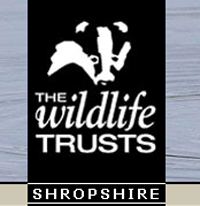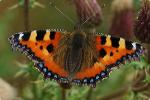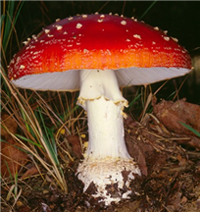Wednesday 5th November 2025, Abbey Manor, Buildwas
Abbey Manor is now a private residence and event venue. Its long history started in the 12th century when it was originally the abbot’s lodging and infirmary of the adjoining Buildwas Abbey. After the abbey’s dissolution it became in turn a private mansion, a farm and, much more recently, Ironbridge Power Station’s social club. At that latter stage the grounds (our venue for the day) were home to the Power Station’s nature trail.
We began our investigations in the more formal garden areas near the house.
Early finds included a Red-rumped Ladybird, Scymnus haemorrhoidalis and some very eye-catching orange fungi, identified as Melastiza cornubiensis.
From here we progressed into an area of more natural grassland which afforded a fine view of the abbey ruins next door.
More Red-rumped Ladybirds were vacuumed, this time in surprisingly large numbers.
Other finds included the bug Stictopleurus punctatonervosus
A Hawthorn Shieldbug
A Forest (or Red-legged) Shieldbug nymph
Small Teasel
 |
| photo: John Martin |
And Nettle-leaved Bellflower
 |
| photo: John Martin |
Lunch was taken, sitting on the trunk of a fallen tree. Moving on, we arrived at the edge of an area of woodland. Sometime around this point a snail was found and declared to be Oxychilus alliarius, the Garlic Snail, so called because it emits a strong smell of garlic when ‘irritated’ (as the FSC AIDGAP guide puts it). On inspection, one member of the party described it as being “as garlic-y as a badger” which left us wondering if this meant it was very ‘garlic-y’, or not ‘garlic-y’ at all! Sadly I do not have a photographic record of this controversial discovery..!
Other finds in and around the woodland included the pseudoscorpion Neobisium carcinoides
The snail-hunting beetle Phosphuga atrata
 |
| photo: Neil Nash |
Small Stagshorn fungus
 |
| photo: Neil Nash |
Orange Ladybird
Adonis Ladybird, unearthed from beneath a log. It was subsequently returned safely to its lodgings..
And leaf mines of the micro moth Phyllonoricter platani. The host-plant for this species, which was only discovered in Britain in 1989, is London Plane, of which there were several in the woods.
 |
| photo: John Martin |
For the last part of the day we decided to decamp to the abbey grounds, accessed via a (usually) locked door from the Manor’s gardens. This gave the opportunity for some fancy photography:
 |
| photo: Liz Roberts |
Here we found the stilitbug Berytinus minor, whilst being watched over by a Robin
 |
| photo: John Martin |
As the visit came to an end the low sun added some colour to the trees behind us in the Manor’s gardens.
A Well Deserved Rest
 |
| Keith & trusty bottle of Lucozade, with Jim contemplating who knows what; Grinshill, August 2016 |
As you will have read in the blog report for Ketley Paddock Mound, the end of the summer 2025 programme also marked the end of an era, as Keith Fowler, our “Dear Leader” retired from his unpaid position as Joy of Wildlife organiser, blogger, all-round inspiration and driving force. A measure of the size of the task that he has undertaken single-handedly since the beginnings of the group c.2012 is that his roles are now being performed by a committee of no fewer than ten people! Please be reassured: Keith is still very much an active participant in Joy of Wildlife and on call to hold the steering group’s hands while they find their feet (we do like a mixed metaphor!). For those of you (like Keith and me) with an interest in Cricket, we look forward to a triumphantly Joe Root-like return to the ranks!
I thought a few pictures of our Dear Leader (retired) in action might be appropriate. Here we find him in March 2017 atop a cliff-face at Pontesford Rocks, having found something to examine….
Shavington Park, May 2018: The burdens of leadership; Keith with first-aid kit, throw line and other baggage, noting down another one of the 65,000 records made by JoW in that overworked notebook (we presume there has been more than one over the years)…
…and assisting Nigel in the unexpected task of vacuuming a tree!
Lilleshall Hill, November 2023, vacuuming (more conventionally this time).
And finally, surveying his Kingdom (or possibly just photographing the view) - Titterstone Clee Hill, August 2017.
Keith, a heartfelt thank you from us all!
Photographs © the author except as noted.





























































































